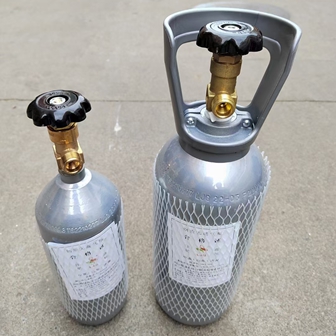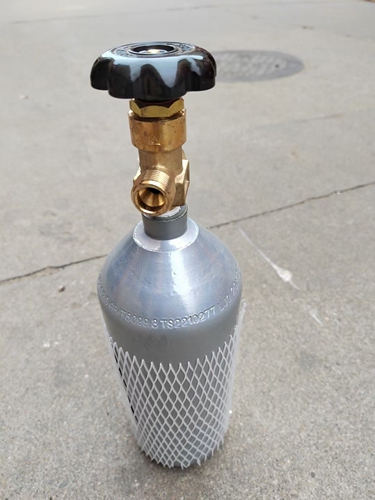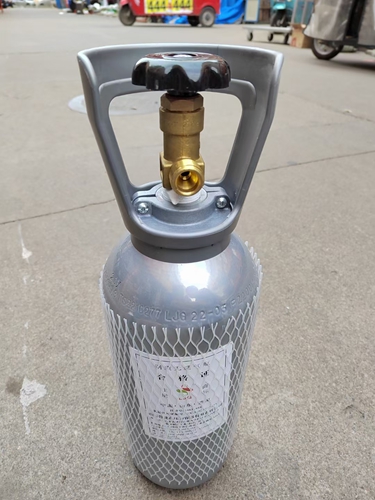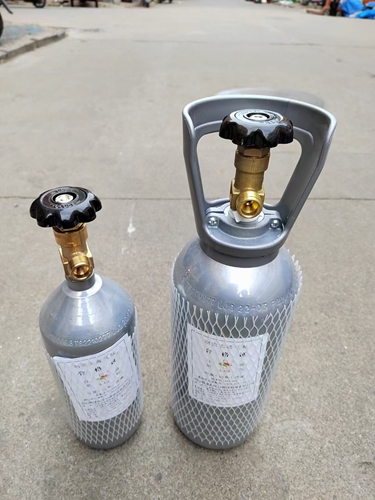
2L 4L CO2 Carbon Dioxide Cylinder
A carbon dioxide cylinder is a pressurized container that holds carbon dioxide gas. It is commonly used for various purposes such as carbonation of beverages, welding, fire extinguishers, and other industrial applications,just like the beer industry requires carbon dioxide cylinders.
The official name for a carbon dioxide cylinder is "Carbon Dioxide Cylinder" or "CO2 Cylinder." This name accurately describes the content and purpose of the cylinder,they are all the same product.
Informally, carbon dioxide cylinders are sometimes referred to as "CO2 tanks" or simply "CO2 canisters." These terms are commonly used in casual conversations or informal settings,everyone can understand.
It's important to note that the specific terminology may vary based on regional conventions or industry-specific jargon. However, the terms mentioned above are widely recognized and commonly used to refer to carbon dioxide cylinders.
A carbon dioxide cylinder is a sturdy, pressurized container designed to store and transport carbon dioxide gas in a compressed form. It is typically made of high-strength materials such as steel,aluminum or composite to withstand the pressure inside the cylinder.
Here are some key features and characteristics of a carbon dioxide cylinder:
Material: Carbon dioxide cylinders are commonly constructed from steel or aluminum, chosen for their strength, durability, and resistance to corrosion. The choice of material depends on factors such as the intended use, transportation requirements, and safety regulations.
Pressure rating: Carbon dioxide cylinders are designed to withstand high pressure. The cylinders are rated for a specific pressure level, usually indicated in pounds per square inch (psi) or bar. The pressure rating ensures the safe containment of the carbon dioxide gas under normal conditions.
Valve: The cylinder is equipped with a valve that allows for controlled release or regulation of the carbon dioxide gas. The valve enables the user to connect various devices or equipment, such as regulators or hoses, to utilize or transfer the gas as needed,for example,QF-2C
Capacity: Carbon dioxide cylinders come in different sizes and capacities, ranging from small portable cylinders used for carbonation of beverages to larger cylinders used in industrial applications. The capacity is typically measured in pounds or kilograms of carbon dioxide gas that can be stored in the cylinder.
Color coding: To aid in easy identification and safety measures, carbon dioxide cylinders are often color-coded. While color coding can vary based on regional standards or specific applications, a common convention is to paint carbon dioxide cylinders in silver or gray.
Safety considerations: Carbon dioxide cylinders should be handled and stored with proper safety precautions. This includes securing the cylinders in an upright position to prevent tipping, keeping them away from heat or flames, and ensuring adequate ventilation when in use.
It's important to note that the use of carbon dioxide cylinders should be in compliance with local regulations and safety guidelines, and appropriate training should be undertaken when handling or operating these cylinders.
Remember, safety is paramount when dealing with pressurized gas cylinders, so always follow the recommended practices and guidelines provided by the manufacturer or relevant authorities.



Material: Carbon dioxide cylinders are commonly constructed from steel or aluminum, chosen for their strength, durability, and resistance to corrosion. The choice of material depends on factors such as the intended use, transportation requirements, and safety regulations.
Pressure rating: Carbon dioxide cylinders are designed to withstand high pressure. The cylinders are rated for a specific pressure level, usually indicated in pounds per square inch (psi) or bar. The pressure rating ensures the safe containment of the carbon dioxide gas under normal conditions.
Valve: The cylinder is equipped with a valve that allows for controlled release or regulation of the carbon dioxide gas. The valve enables the user to connect various devices or equipment, such as regulators or hoses, to utilize or transfer the gas as needed,for example the QF-2.
Capacity: Carbon dioxide cylinders come in different sizes and capacities, ranging from small portable cylinders used for carbonation of beverages to larger cylinders used in industrial applications. The capacity is typically measured in pounds or kilograms of carbon dioxide gas that can be stored in the cylinder.
Color coding: To aid in easy identification and safety measures, carbon dioxide cylinders are often color-coded. While color coding can vary based on regional standards or specific applications, a common convention is to paint carbon dioxide cylinders in silver or gray.
Safety considerations: Carbon dioxide cylinders should be handled and stored with proper safety precautions. This includes securing the cylinders in an upright position to prevent tipping, keeping them away from heat or flames, and ensuring adequate ventilation when in use.
It's important to note that the use of carbon dioxide cylinders should be in compliance with local regulations and safety guidelines, and appropriate training should be undertaken when handling or operating these cylinders.
Remember, safety is paramount when dealing with pressurized gas cylinders, so always follow the recommended practices and guidelines provided by the manufacturer or relevant authorities.








